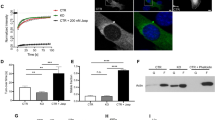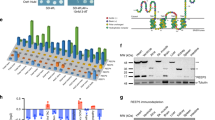Abstract
p130Cas (Cas), the protein encoded by the Crkas gene (also known as Cas), is an adaptor molecule with a unique structure that contains a Src homology (SH)-3 domain followed by multiple YXXP motifs and a proline-rich region1. Cas was originally cloned as a highly tyrosine-phosphorylated protein in cells transformed by v-Src (refs 2,3) or v-Crk (ref. 4) and has subsequently been implicated in a variety of biological processes including cell adhesion5, cell migration6, growth factor stimulation7,8,9, cytokine receptor engagement10,11 and bacterial infection12,13. To determine its role in vivo, we generated mice lacking Cas. Cas-deficient embryos died in utero showing marked systemic congestion and growth retardation. Histologically, the heart was poorly developed and blood vessels were prominently dilated. Electron microscopic analysis of the heart revealed disorganization of myofibrils and disruption of Z-disks. In addition, actin stress fiber formation was severely impaired in Cas-deficient primary fibroblasts. Moreover, expression of activated Src in Cas-deficient primary fibroblasts did not induce a fully transformed phenotype, possibly owing to insufficient accumulation of actin cytoskeleton in podosomes. These findings have defined Cas function in cardiovascular development, actin filament assembly and Src-induced transformation.
This is a preview of subscription content, access via your institution
Access options
Subscribe to this journal
Receive 12 print issues and online access
$209.00 per year
only $17.42 per issue
Buy this article
- Purchase on Springer Link
- Instant access to full article PDF
Prices may be subject to local taxes which are calculated during checkout




Similar content being viewed by others
References
Sakai, R. et al. A novel signaling molecule, p130, forms stable complexes in vivo with v-Crk and v-Src in a tyrosine phosphorylation-dependent manner. EMBO J. 13, 3748–3756 ( 1994).
Reynolds, A.B., Kanner, S.B., Wang, H.C. & Parsons, J.T. Stable association of activated pp60src with two tyrosine-phosphorylated cellular proteins. Mol. Cell. Biol. 9, 3951–3958 (1989).
Kanner, S.B., Reynolds, A.B., Wang, H.C., Vines, R.R. & Parsons, J.T. The SH2 and SH3 domains of pp60src direct stable association with tyrosine phosphorylated proteins p130 and p110. EMBO J. 10, 1689–1698 (1991).
Matsuda, M., Mayer, B.J., Fukui, Y. & Hanafusa, H. Binding of transforming protein, P47gag-crk, to a broad range of phosphotyrosine-containing proteins. Science 248, 1537–1539 (1990).
Nojima, Y. et al. Integrin-mediated cell adhesion promotes tyrosine phosphorylation of p130Cas, a Src homology 3-containing molecule having multiple Src homology 2-binding motifs. J. Biol. Chem. 270, 15398– 15402 (1995).
Cary, L.A., Han, D.C., Polte, T.R., Hanks, S.T. & Guan, J.-L. Identification of p130Cas as a mediator of focal adhesion kinase-promoted cell migration. J. Cell Biol. 140, 211–221 ( 1998).
Ribon, V. & Saltiel, A.R. Nerve growth factor stimulates the tyrosine phosphorylation of endogenous Crk-II and augments its association with p130Cas in PC-12 cells. J. Biol. Chem. 271, 7375–7380 (1996).
Ojaniemi, M. & Vuori, K. Epidermal growth factor modulates tyrosine phosphorylation of P130Cas. J. Biol. Chem. 272, 25993–25998 ( 1997).
Casamassima, A. & Rozengurt, E. Tyrosine phosphorylation of p130(cas) by bombesin, lysophosphatidic acid, phorbol esters, and platelet-derived growth factor. Signaling pathways and formation of a p130(cas)-Crk complex. J. Biol. Chem. 272, 9363–9370 (1997).
Schraw, W. & Richmond, A. Melanoma growth stimulatory activity signaling through the class II interleukin-8 receptor enhances the tyrosine phosphorylation of Crk-associated substrate, p130, and a 70-kilodalton protein . Biochemistry 34, 13760– 13767 (1995).
Ingham, R.J. et al. B cell antigen receptor signaling induces the formation of complexes containing the Crk adapter proteins. J. Biol. Chem. 271, 32306–32314 (1996).
Black, D.S . & Bliska, J.B. Identification of p130Cas as a substrate of Yersinia YopH (Yop51), a bacterial protein tyrosine phosphatase that translocates into mammalian cells and targets focal adhesions . EMBO J. 16, 2730–2744 (1997).
Persson, C., Carballeira, N., Wolf-Watz, H. & Fallman, M. The PTPase YopH inhibits uptake of Yersinia, tyrosine phosphorylation of p130Cas and FAK, and the associated accumulation of these proteins in peripheral focal adhesions. EMBO J. 16, 2307– 2318 (1997).
Sanger, J.W., Mittal, B. & Sanger, J.M. Analysis of myofibrillar structure and assembly using fluorescently labeled contractile proteins. J. Cell Biol. 98, 825–833 (1984).
Ishino, M., Ohba, T., Sasaki, H. & Sasaki, T. Molecular cloning of a cDNA encoding a phosphoprotein, Efs, which contains a Src homology 3 domain and associates with Fyn. Oncogene 11, 2331–2338 (1995).
Alexandropoulos, K. & Baltimore, D. Coordinate activation of c-Src by SH3- and SH2-binding sites on a novel p130Cas-related protein, Sin. Genes Dev. 10, 1341– 1355 (1996).
Law, S.F. et al. Human enhancer of filamentation 1, a novel p130cas-like docking protein, associates with focal adhesion kinase and induces pseudohyphal growth in Saccharomyces cerevisiae. Mol. Cell. Biol. 16, 3327–3337 ( 1996).
Minegishi, M. et al. Structure and function of Cas-L, a 105-kD Crk-associated substrate-related protein that is involved in beta-1 integrin-mediated signaling in lymphocytes . J. Exp. Med. 184, 1365– 1375 (1996).
Chen, Z., Friedrich, G.A. & Soriano, P. Transcriptional enhancer factor 1 disruption by a retroviral gene trap leads to heart defects and embryonic lethality in mice. Genes Dev. 8, 2293–2301 (1994).
Yoshida, K. et al. Targeted disruption of gp130, a common signal transducer for the interleukin 6 family of cytokines, leads to myocardial and hematological disorders. Proc. Natl Acad. Sci. USA 93, 407– 411 (1996).
Kuo, C.T. et al. GATA4 transcription factor is required for ventral morphogenesis and heart tube formation. Genes Dev. 11, 1048– 1060 (1997).
Kwee, L. et al. Defective development of the embryonic and extraembryonic circulatory systems in vascular cell adhesion molecule (VCAM-1) deficient mice. Development 121, 489–503 ( 1995).
Ilic, D. et al. Reduced cell motility and enhanced focal adhesion contact formation in cells from FAK-deficient mice. Nature 377, 539 –543 (1995).
Jove, R. & Hanafusa, H. Cell transformation by the viral src oncogene . Annu. Rev. Cell Biol. 3, 31– 56 (1987).
Boschek, C.B. et al. Early changes in the distribution and organization of microfilament proteins during cell transformation. Cell 24, 175 –184 (1981).
Fincham, V.J. & Frame, M.C. The catalytic activity of Src is dispensable for translocation to focal adhesions but controls the turnover of these structures during cell motility. EMBO J. 17 , 81–92 (1998).
Tarone, G., Cirillo, D., Giancotti, F.G., Comoglio, P.M. & Marchisio, P.C. Rous sarcoma virus-transformed fibroblasts adhere primarily at discrete protrusions of the ventral membrane called podosomes . Exp. Cell Res. 159, 141– 157 (1985)
Lipsich, L.A., Lewis, A.J. & Brugge, J.S. Isolation of monoclonal antibodies that recognize the transforming proteins of avian sarcoma viruses. J. Virol. 48, 352–360 (1983).
Evan, G.I., Lewis, G.K., Ramsay, G. & Bishop, J.M. Isolation of monoclonal antibodies specific for human c-myc proto-oncogene product. Mol. Cell. Biol. 5, 3610–3616 (1985).
Morrison, D.K., Kaplan, D.R., Rhee, S.G. & Williams, L.T. Platelet-derived growth factor (PDGF)-dependent association of phospholipase C-gamma with the PDGF receptor signaling complex. Mol. Cell. Biol. 10 , 2359–2366 (1990).
Acknowledgements
We thank E. Robertson for providing us with the CCE ES cells, S. Muroi and M. Tanaka for technical advice regarding the culture of ES cells and K. Katsuki for helpful comments. We also thank S. Iwasaka and Y. Oh-hira for preparing pathological specimens and N. Machiyama for photographs. This work was in part supported by Grants-in-Aids from the Ministry of Education, Science and Culture of Japan.
Author information
Authors and Affiliations
Corresponding author
Rights and permissions
About this article
Cite this article
Honda, H., Oda, H., Nakamoto, T. et al. Cardiovascular anomaly, impaired actin bundling and resistance to Src-induced transformation in mice lacking p130Cas. Nat Genet 19, 361–365 (1998). https://doi.org/10.1038/1246
Received:
Accepted:
Issue Date:
DOI: https://doi.org/10.1038/1246
This article is cited by
-
p130Cas is required for androgen-dependent postnatal development regulation of submandibular glands
Scientific Reports (2023)
-
Nuclear deformation guides chromatin reorganization in cardiac development and disease
Nature Biomedical Engineering (2021)
-
P130Cas/bcar1 mediates zebrafish caudal vein plexus angiogenesis
Scientific Reports (2020)
-
Conditional ablation of p130Cas/BCAR1 adaptor protein impairs epidermal homeostasis by altering cell adhesion and differentiation
Cell Communication and Signaling (2018)
-
A ligand-independent integrin β1 mechanosensory complex guides spindle orientation
Nature Communications (2016)



